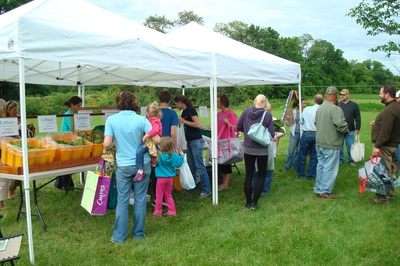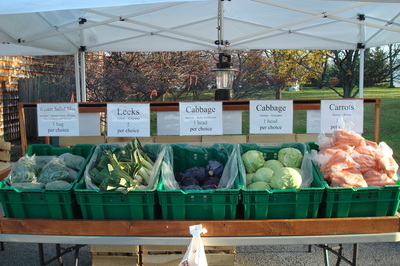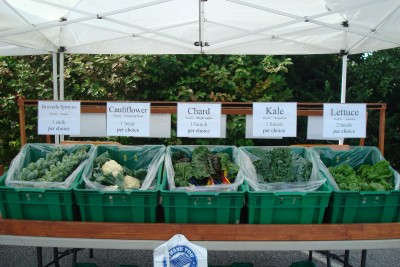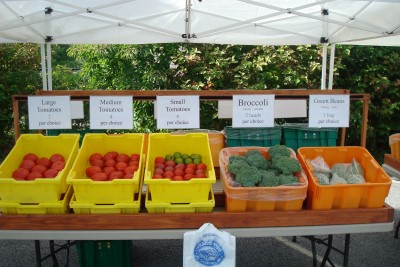Think of membership to our farm as a weekly farmers market trip—paid for ahead of time.
Get to know who grows your food while enjoying fresh harvested vegetables and fruits.
All of the harvest from our farm is distributed to you, the members.
Shares are not pre-boxed. Instead you pick 8 choices from a market style set up.
Our CSA Model
There are many variations on this concept that have developed over time. At Healthy Harvest Farm we believe the best way to operate a CSA is to make it the sole outlet for all that is grown on the farm. Good farming practices and a large variety of crops ensures that every year will provide a wide selection of produce for our members. However, for all of our planning and knowledge, farming still depends on Mother Nature and some years she is kinder than others. Every year certain crops will do better than others, but because we don't sell our produce outside of the CSA when we have a bumper crop the members get it all.

The bounty at Healthy Harvest Farm will be distributed on a weekly basis from June thru October for the Summer share and on a biweekly basis from December thru April for the Winter share. The produce is not pre-boxed so you get to choose the items you like. Every week we offer a wide selection of produce and you get to select 8 items. Early in the season the selection is about 10 items but increases as the summer progresses so that by fall their are often more then 15 items to pick from. For example, a typical week in the summer the choices would look as follows: 2 heads lettuce, 1 bag carrots, 3 onions, 1 bag basil, 4 tomatoes, 2 bell peppers, 6 hot peppers, 1 pound green beans, 2 zucchinis, 2 cucumber, 1 globe eggplant, 3 Asian eggplant, 1 watermelon, 1 cantaloupe. From this large list of choices each share gets to select 8. You can even take multiple choices of the same vegetable. This gives the customer the flexibility to customize the share to their taste and allows us to offer a large choice of seasonal produce. At times it is necessary to limit certain popular items that we have small quantities of to ensure everyone gets a share. For example snap peas are usually limited to one container per share because they are so popular yet time intensive to grow. The idea is that no matter what time you come to distribution the selection is the same.

Eating seasonally can take some getting used to. The grocery store offers most items of produce year round. The trade off for that convenience is reduced quality, taste, and nutrient content. The produce you get from our farm is always picked at the height of ripeness giving you exceptional taste and nutrient content. The longer produce spends in transit and storage the more nutrients are lost. At Healthy Harvest you will enjoy field ripened melons that are only available in summer, but one bite and you will never buy melons in the grocery store again. Experiencing seasonal produce can take some patience. In our area field tomatoes don't really start producing till the end of July or August which is surprising to most people, but the taste of fresh tomatoes more than makes up for the wait.
History of Community Supported Agricultural
Community Supported Agriculture (CSA) got started in the early 1960's in Japan, Germany and Switzerland when people became concerned about the lose of local agriculture. By the 1980's it had reached the United States.

The underlying principle is that community residents decide to support a local farm by paying the farm at the beginning of the season for a share of the harvest. This ensures the farm has the cash flow to operate at the beginning of the season when most of the expenses occur such as seeds, soil amendments, greenhouse supplies, and tractor expenses but most crops are not ready to harvest to replace the cash going out. In return the members share in the bounty and have a tangible connection to the farm.

The really unique thing about joining a CSA is the personal connection you will develop with the farm and people who grow your food. You become part of a community of people who want to eat great tasting nutritious food while ensuring that farmland in their area doesn't become a thing of the past.